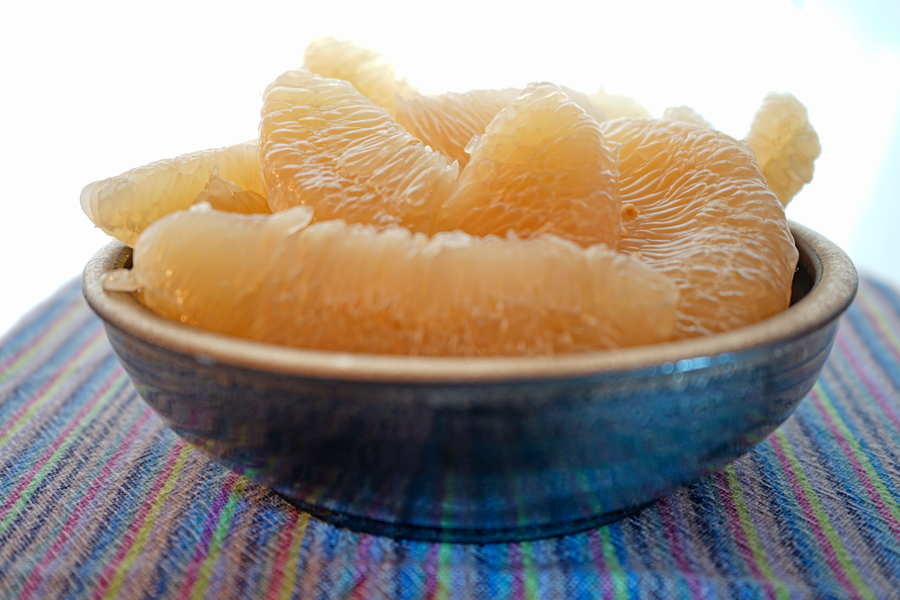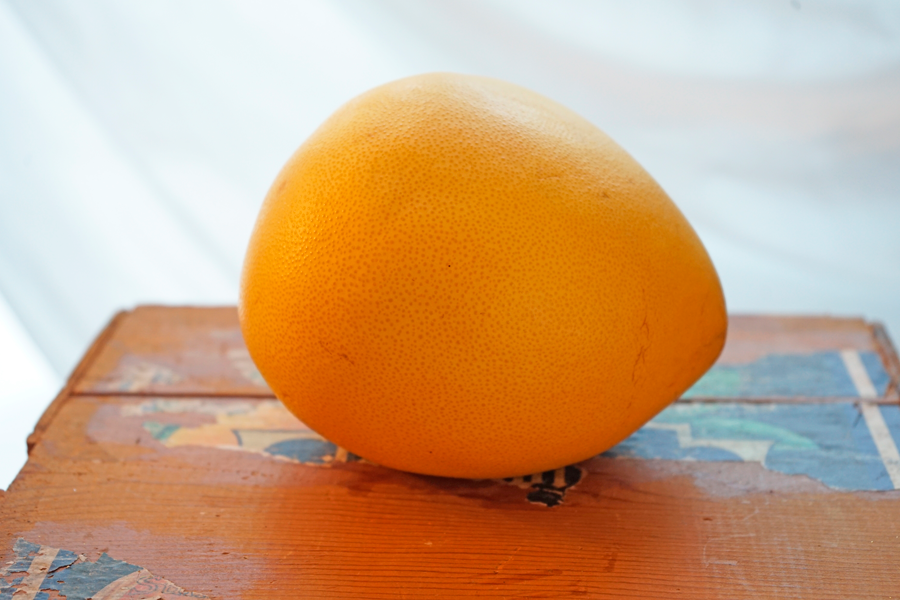What’s that food?
If you take an average size grapefruit and imagine it’s been quadrupled, you will get an idea of this month’s WTF. Pomelo (or pummelo, pomello, pumelo—each spelling is correct) is a type of citrus fruit native to south and southeast Asia. It’s the biggest of all citrus fruit, can weigh between one and two kilograms, and grow to between 15 and 25 centimetres. Pomelo trees reach 6–13 metres (20–43 feet) in height.
Generally, the fruit has a yellow skin and can have a slightly pointed end. The skin is thick and the fruit inside is surrounded by a thick white layer of spongy flesh. To peel it, use a knife to slice the end off, score the rind four to eight times, and slowly peel it back. Under the thick inner layer, the pomelo fruit is revealed.

Photo credit: Cheryl Young/Salty
Like any other citrus fruit, it is segmented, but the segments are covered in a tough papery membrane that should be removed before eating. Peel and simply enjoy the fruit.
Pomelo is the least acidic of all citrus fruit and it does not taste as sour or bitter as other citrus fruit can. It is also less juicy than other citrus. Like a grapefruit, its flesh is semi-transparent and can vary in colour from pale yellow, lime, or dark pink, depending on the variety. Generally in stores on PEI, the variety sold is the Honey Pomelo, which has a light yellow skin and flesh.
It is believed that the pomelo is one of the original citrus species from which the rest of citrus fruits have been hybridized. For example, grapefruit is a cross between a pomelo and an orange.
Like many fruits and vegetables it spread from east to west with explorers and is now grown in both eastern countries (like China, Japan, India, Fiji, Malaysia, and Thailand) as well as in the Caribbean and the United States.
Along with the flesh of the pomelo, its peel is used to make marmalade, can be candied or dipped in chocolate, or as in Sri Lanka, eaten as a dessert, raw and sprinkled with sugar. In Vietnam, the tree’s flowers are used to make perfume, and the hard wood of a pomelo tree can be used for making tool handles.

A pomelo is the largest citrus fruit Photo credit: Cheryl Young/Salty
The fruit contains high amounts of vitamin C (a whole pomelo can have 600% of one’s daily requirement), potassium, dietary fiber, vitamin B6, and magnesium.
Pomelos are generally best eaten between late November and March. Once you bring your pomelo home, keep it on the counter for no more than five to six days. Once peeled and segmented, it can be stored in the fridge, but let it come to room temperature before serving for best flavour.
- WTF - December 2, 2020
- WHAT GOES AROUND COMES AROUND - June 12, 2020
- Salty’s 2020 Gift Guide - December 2, 2020
- A RETURN OF DELIVERY - May 6, 2020
- ICYMI - April 22, 2020
- NEW BIOMASS BOILERS FOR LOCAL GREENHOUSE - March 31, 2020
- TOP CHEF CANADA COMPETITOR FROM PEI - March 4, 2020
- FOOD INSECURE - March 1, 2020
- ACCESS TO FRESH PRODUCE - March 1, 2020
- POLITICS OF SCHOOL FOOD - March 1, 2020


